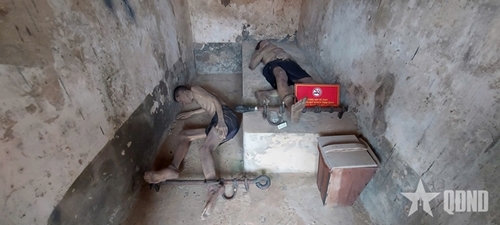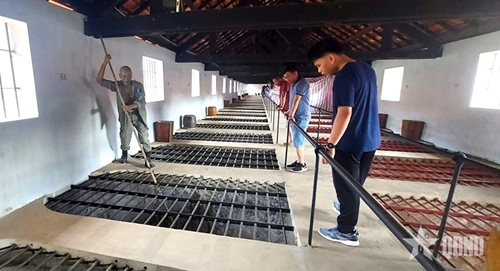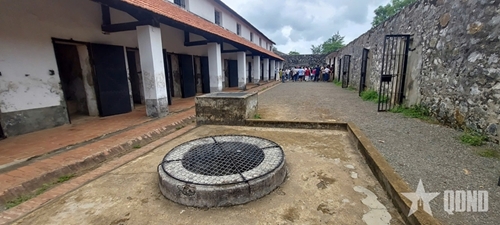Defending fledgling government
In the early years of the resistance war against the French colonialists, the Mekong Delta was divided into two war zones: War Zone 8 and War Zone 9. When the French returned, the region became a harsh and fierce theater, with continuous and intense fighting. Alongside the local forces, veteran communists returning from Con Dao Prison joined in forming the first military units, becoming the core force that resisted the invaders.
    |
 |
|
Con Dao prison – the so-called “Hell on Earth” |
The August Revolution of 1945 was a significant political event for the nation, transforming Vietnam from a semi-feudal colony into an independent country and turning its people from the status of slaves into masters of their land. However, immediately after this success, the country faced extremely difficult circumstances. Reactionary forces inside the country, in collusion with colonial powers and external forces, sought to strangle the fledgling government and reimpose their domination for a second time.
At that time, on August 18, 1945, a special meeting was held in the South between the Southern Party Committee and the Provisional Administrative Committee. The meeting addressed urgent issues to stabilize the situation and safeguard the fledgling government, with a crucial decision to bring communist soldiers from Con Dao Prison back to the mainland to reinforce the forces and strengthen revolutionary leadership.
After the meeting, preparations were rushed forward, from gathering forces and repairing equipment to hiring boats, mobilizing sailors, and mapping the route, all amidst great hardships and challenges.
Sea-crossing journey
On September 16, 1945, the ship Phu Quoc, accompanied by 32 small boats and about 200 sailors, set sail from the Tran De estuary toward Con Dao Island. They braved towering waves and fierce winds as the boats drifted with the current, some sailors collapsing from seasickness while others bailed water to keep the mission alive.
    |
 |
|
A cell where communists were held in Con Dao Prison |
    |
 |
|
Visitors explore Con Dao Prison. |
Leading the convoy was Ly Van Chuong’s ship, which was battered by raging waves. The helmsman urged a retreat to shore and suggested waiting until the storm passed before sailing out again. The leader firmly refused, knowing that if the lead ship turned back, the fleet’s morale would collapse. For nearly three hours, they endured the storm’s fury until the sea finally calmed. Still, seven boats were swept off course and forced back to Con Noc and reached Con Dao only three days later.
At dawn on September 17, the convoy landed one by one at Co Ong Beach, marking the success of their perilous journey. Six days later, on September 23, the ship Phu Quoc and 23 boats carried more than 1,800 political prisoners to Dai Ngai Port, where they were welcomed with the heartfelt joy of the people.
Notably, comrade Ton Duc Thang gave up his seat on the boats so that more prisoners could return to the mainland. Instead, he painted the word “Liberation” on a small, newly repaired motorboat and steered it himself to follow the convoy. The act embodied his compassion, resilience, and noble spirit, the very qualities of the hero who would later become President.
Renewing resolve and faith for revolution.
There is a special coincidence that, the communist soldiers returned from Con Dao Prison to the mainland on September 23, 1945, which was also the day French colonialists, under the guise of Allied forces, launched their second invasion. Their joy of freedom was fleeting, as they immediately joined a new and grueling struggle for independence, one foreseen to be long, arduous, and fierce.
    |
 |
|
A corner of Con Dao prison |
At that time, the South and the Mekong Delta faced immense challenges, and their return provided crucial leadership and military expertise. Steeled by years in Con Dao, the so-called “hell on earth,” these revolutionaries rekindled courage and faith, giving fresh strength to the southern resistance in its darkest hours.
On October 15, 1945, shortly after the return of key comrades from Con Dao, the Southern Party Committee convened in My Tho to adopt the “bare ground resistance” strategy. The meeting also unified provincial committees and the Viet Minh Front, consolidating leadership for the armed struggle as French forces returned to invade the South.
In December, the Inter-Provincial Party Committee of the Western Region met in O Mon (Can Tho). The meeting reviewed the military situation, assessed the strength of local armed forces, and announced the establishment of 2 war zones and their leadership. In War Zone 8, Dao Van Truong, was Zone Commander, and Vo Si, a former Con Dao prisoner, was Political Commissar. In War Zone 9, Vu Duc served as Zone Commander, with Phan Trong Tue, another Con Dao returnee, as Political Commissar.
Local armed units were mobilized to support Can Tho, while provinces not yet occupied by the enemy strengthened their forces and produced makeshift weapons. These early efforts played a vital role in halting the French advance and defending the gains of the August Revolution.
The second resistance war against the French colonialists lasted nine years, culminating in the decisive Dien Bien Phu victory, followed by the 21-year struggle against the U.S. Throughout these conflicts, the communist prisoners returned from Con Dao consistently demonstrated their courage, strategic acumen, and unwavering loyalty to the Party, the nation, and the people.
    |
 |
|
Every year, a large number of visitors come to tour and learn about the history of Con Dao prison. |
These comrades fought as heroes in the nation’s sacred wars, many rising to become prominent leaders steering the revolutionary course, including President Ton Duc Thang, General Secretary Le Duan, General Secretary Nguyen Van Linh, and Chairman of the Council of Ministers Pham Hung.
Eight decades have passed since the ships brought these veteran revolutionaries from Con Dao to the mainland. Alongside the August Revolution, their return stands as an enduring testament to the heroic struggle of the Vietnamese people against foreign invaders in the 20th century.
Translated by Ninh Vinh – Hoang Truong